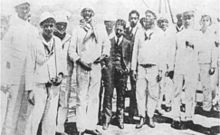Revolta da Chibata
A Revolta da Chibata ( The Revolt of the Whip ) was a revolt of mostly dark-skinned Brazilian seamen in the Brazilian Navy in November 1910. Over 2,000 seamen rebelled against the physical violence punishment by their fair-skinned superiors.
The uprising was planned for over two years and was carried out by the crews of four large warships under the leadership of the seaman João Cândido Felisberto (* June 24, 1880; † December 6, 1969). The revolt came from the new battleship Minas Geraes ( Minas Geraes class ) and attacked its sister ship São Paulo , the old coastal battleship Deodoro and the cruiser Bahiaabove. Smaller ships were also taken over, but the crews changed to reinforce the crews on the four ships mentioned, which thus formed the rebels' fleet. Most officers and employees loyal to them were allowed to move ashore freely there.
The officers came almost exclusively from the upper class of Brazil, which had previously prevented reforms. The slavery in Brazil was officially abolished in 1888, more Western than the last country culture. The following year the monarchy was overthrown and the republic was introduced. However, the situation of the black Brazilians was legally unclear. Ultimately, corporal punishment such as flogging on land was banned. In the navy, however, it was retained because the simple ranks were valued extremely negligibly - juveniles of the lower classes who had committed criminal offenses were often put in education camps and obliged to serve from around the age of 16. Indiscriminate coercive obligations in the slums are also known from this period.
When the ships were taken over on November 22, 1910, six were killed, including Joao Batista das Neves, the commander of the battleship Minas Geraes . He died when he tried to defend himself against the mutineers with a revolver. A few volleys were then shot over the city of Rio de Janeiro to show that they had the gun violence. A messenger sent the demands to the government concerning the abolition of punishment by flogging, improvement of the food and amnesty for all mutineers.
On the morning of November 23, 1910, the city was faced with a fleet of guns against which it had no antidotes. Immediately, however, the government began planning the violent suppression of the uprising and ordered the remaining ships of the Brazilian Navy to come. To buy time, she sent a negotiator to the ships, José Carlos de Carvalho. However, he then reported that the insurgents were well organized and that their fleet (to the astonishment of the officers) was able to drive in formation. Since one of the dreadnought ships already had more firepower than the entire remaining artillery, the only effective option was to sink the ships with torpedoes.
A heated dispute broke out within the government and in parliament about this question. The warships that had just been procured were actually supposed to secure Brazil's rise to international power and were already a high financial burden when procured. All other ships were militarily completely out of date and completely inferior in the ABC arms race of that time. So the situation was finally resolved in such a way that on November 24th a decision was worked out that corresponded to the demands of the insurgents, and on November 25th it was submitted to the House of Commons for approval.
After a pause for thought, the insurgents accepted and maneuvered the ships back for handover (they had meanwhile gone out to sea to prevent possible attacks and torpedoes). The ships were returned to the Navy on November 26th. By the next day most of the mutineers were put ashore, and the cannons were put out of action in the following days.
In the further course, there was considerable tension in the crews, so that it was decided to dismiss all the insurgent seamen. The fear of disobeying orders was so great that 1,300 dismissals were announced and the resulting gaps were filled with Portuguese seafarers from merchant ships. In addition, the government claims to have issued over 1,000 travel documents so that those released could return to their home villages.
In the course of the changes on the ships, there was now another revolt on December 9th. However, it could not only be knocked down, but also provided the pretext to arrest the former crew members. Actually, the new revolt cannot have anything to do with the first uprising, so that it ultimately represents a breach of the amnesty promise. Over 600 seafarers were caught - and most of the leaders of the original uprising died in prisons that same day. The remaining men were sent to the plantations further north for forced labor , where many perished in the following years under the extremely hot working conditions.
João Cândido Felisberto was one of the few who survived the torture , but contracted severe pneumonia. The “Black Admiral” (“Almirante Negro”) called by the press worked for years as a poorly paid dock worker after he recovered. In politics he only appeared as a member of the Integralists from 1933 . Other political consequences of the uprising are barely visible - at most, from then on the recruits of the Navy had to at least be able to read and write.
literature
- Moacir C. Lopes: O almirante negro. Revolta da Chibata . Quartet Editorial, Rio de Janeiro 2000, ISBN 85-85696-30-3 .
- Edmar Morél: A revolta da chibata . 3rd edition. Editorial Graal, Rio de Janeiro 1979.
Web links
- Portrait of João Cândido Centenário da Revolta da Chibata ( Memento from December 12, 2011 in the Internet Archive )


